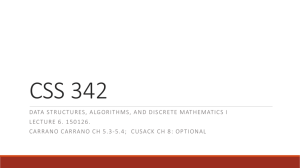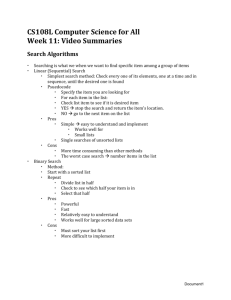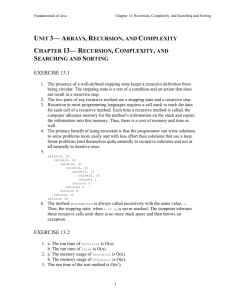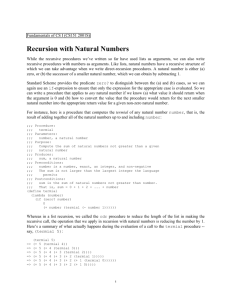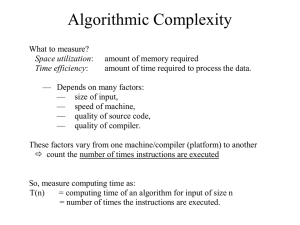Exercises
advertisement
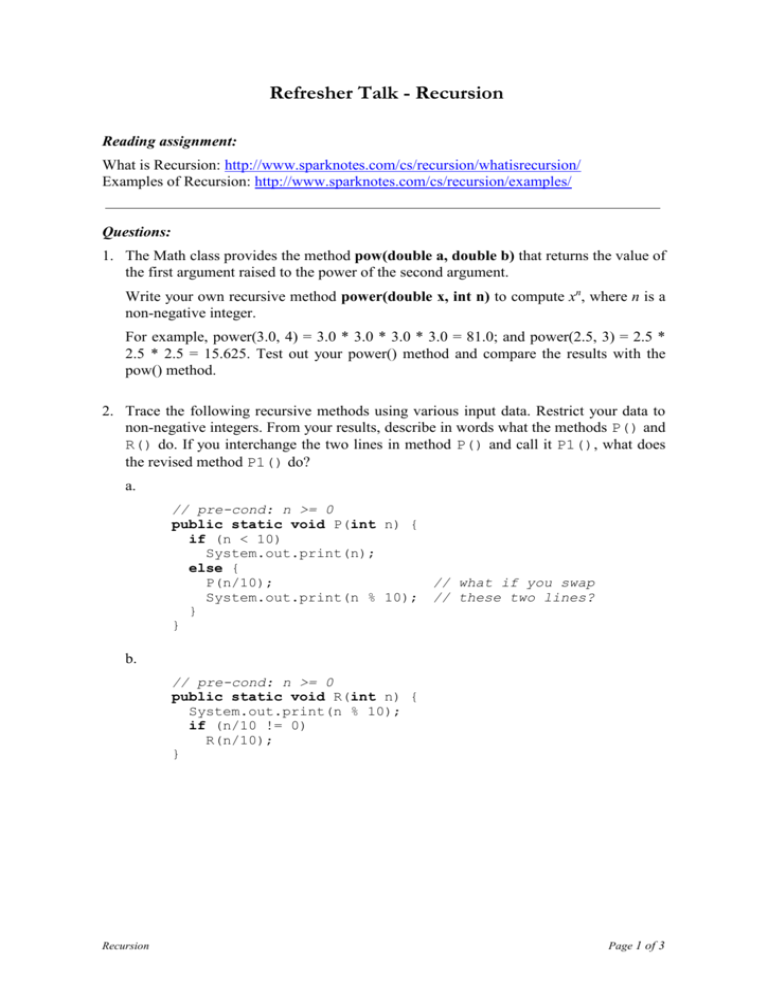
Refresher Talk - Recursion
Reading assignment:
What is Recursion: http://www.sparknotes.com/cs/recursion/whatisrecursion/
Examples of Recursion: http://www.sparknotes.com/cs/recursion/examples/
Questions:
1. The Math class provides the method pow(double a, double b) that returns the value of
the first argument raised to the power of the second argument.
Write your own recursive method power(double x, int n) to compute xn, where n is a
non-negative integer.
For example, power(3.0, 4) = 3.0 * 3.0 * 3.0 * 3.0 = 81.0; and power(2.5, 3) = 2.5 *
2.5 * 2.5 = 15.625. Test out your power() method and compare the results with the
pow() method.
2. Trace the following recursive methods using various input data. Restrict your data to
non-negative integers. From your results, describe in words what the methods P() and
R() do. If you interchange the two lines in method P() and call it P1(), what does
the revised method P1() do?
a.
// pre-cond: n >= 0
public static void P(int n) {
if (n < 10)
System.out.print(n);
else {
P(n/10);
System.out.print(n % 10);
}
}
// what if you swap
// these two lines?
b.
// pre-cond: n >= 0
public static void R(int n) {
System.out.print(n % 10);
if (n/10 != 0)
R(n/10);
}
Recursion
Page 1 of 3
3. Given the following method Q().
public static void Q(int n1, int n2) {
if (n2 <= 0)
System.out.println();
else {
Q(n1 – 1, n2 - 1);
System.out.print(n1 + " ");
Q(n1 + 1, n2 – 1);
}
}
a. What output is produced by the call Q(14, 3)? [Hint: First try Q(14,1), then
Q(14,2)].
b. If the System.out.print(n1 + " ") statement is moved before the first
recursive call to Q(), what output will be produced by Q(14,3)?
Write out a complete program to test out this method to check that the actual outputs
match your answers above.
4. In a special town where you are only allowed to walk northwards or eastwards, each of
the following examples shows the total number of unique north-east paths ne(x, y) to
get from point A to point B, where B is x rows north and y columns east of A. Assume
that x and y are non-negative integers. By convention, ne(0, 0) is 1.
B
A
B
A
B
B
A
A
A
A
ne(0,2) = 1
B
B
ne(1,3) = 4
ne(2,2) = 6
Write a recursive method to compute the number of north-east paths.
5. Study the code below and if you like, trace the recursive method mystery(). What is
the smaller version of the task on which the recursive call works? How does the
original problem relate to the smaller problem? What does the method compute?
public static void main(String[] args)
throws IOException {
// code to read values into list - omitted
System.out.println("Answer = " +
mystery(list, list.length));
}
Recursion
Page 2 of 3
// pre-cond: n > 0
public static int mystery(int[] a, int n) {
if (n == 1)
return a[0];
else {
int m = mystery(a, n-1);
return a[n-1] > m ? a[n-1] : m;
}
}
6. Is the code in question 5 a “going-up”, “going-down” or “split-half” recursion? Write
the other two versions. You may also try any other version.
7. In question 4 above, we discussed the north-east paths problem. Now, modify the
method so that besides reporting the number of possible paths, it also lists out all the
possible paths, using ‘N’ to denote a step to the north and ‘E’ a step to the East.
(Hint: You may represent the path taken so far as a string. Pass this string into the
recursive call.)
You are allowed to violate the principle of cohesion for the sake of convenience here,
that is, you may print the paths and return the number of paths in your method.
B
A
B
A
B
B
B
B
A
A
A
ne(0,2) = 1
A
ne(1,3) = 4
ne(2,2) = 6
The following are some sample outputs.
Enter x: 0
Enter y: 2
E E
Number of paths = 1
Enter x: 1
Enter y: 3
N E E E
E N E E
E E N E
E E E N
Number of paths = 4
Recursion
Enter x: 2
Enter y: 2
N N E E
N E N E
N E E N
E N N E
E N E N
E E N N
Number of paths = 6
Page 3 of 3





